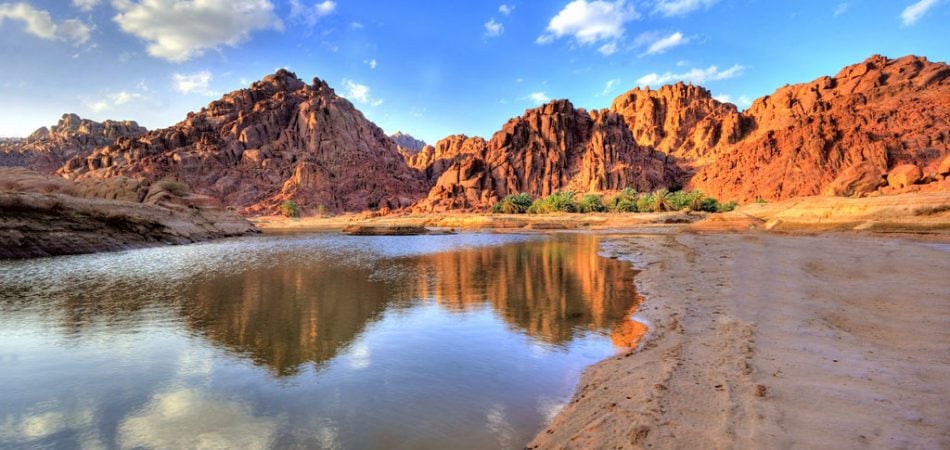
Water quality in KSA is acceptable for drinking with respect to chemical characteristics. However, bacteriological contamination has been detected in several regions. This can result from network leakages or old and poorly maintained storage tanks.[1]
Groundwater quality
The continued extraction of non-renewable groundwater leads to deterioration in water quality and salinity levels in the groundwater layers. For instance, high levels of total dissolved solids (TDS) have been detected in the Biyadh and Wasia aquifers, at an average of 2,131 milligrams per litre (mg/L).[2]
Concentrations of radioactive elements (e.g. radium) have been reported in aquifers such as Saq. Moreover, groundwater extraction has increased the concentration of radionuclides in aquifers.[3] [4] High nitrate levels have been detected in regions where agricultural activities are dominant.[5] High fluoride concentrations have also been reported in many areas.[6] This was attributed to the intensive usage of fertilizers, pesticides and animal waste.
A 2015 study concluded that the groundwater in the Hail aquifer was suitable for irrigation. However, it was not suitable for drinking purposes because most of the water quality variables exceeded the limits specified by regional and international standards. For instance, a high concentration of iron (Fe) and lead (Pb) was detected.[7] More recently, another study was conducted to evaluate heavy metal contamination and groundwater quality in southern Saudi Arabia. The maximum values of arsenic (As), manganese (Mn), chromium (Cr), nickel (Ni), selenium (Se) and zinc (Zn) were above the permissible limits for drinking water purposes. Pollution indices indicated that 20-52% of samples were suitable for agricultural and domestic purposes.[8]
Marine water quality
Saudi Arabia’s coastline exceeds 3,500 km. More than 2,400 km of this extends along the Red Sea while the rest lies on the Arabian Gulf. Along these coasts, concentrated activities occur related to oil, petrochemical industries, power and desalination activities, and other industrial and development efforts. These activities cause seawater pollution, which impacts the marine environment and human well-being. The major pollutants are sewage outfalls, oil and chemical plumes, thermal waters and sediment transport. This environmental condition is being examined and environmental legislation is being considered by several ministries.[9]
The Persian Gulf is considered to be among the highest anthropogenically impacted regions. Heavy metal contamination in coastal and marine environments is becoming a serious threat to both the naturally stressed marine ecosystems and humans who rely on marine resources for food, industry and recreation. Heavy metals are introduced to coastal and marine environments through different sources and activities, including sewage and industrial effluents, brine discharges and oil pollution.[10]
[1] Alqahtani, JM et al., 2015. Drinking water quality and public health in south-western Saudi Arabia: The need for a national monitoring programme. Journal of Family and Community Medicine 22(1): 19-24.
[2] Zaidia, FK et al., 2016. Evaluation of groundwater chemistry and its impact on drinking and irrigation water quality in the eastern part of the Central Arabian graben and trough system, Saudi Arabia. Journal of African Earth Sciences 120: 208-219.
[3] Ministry of Environment, Water and Agriculture, 2018. National Water Strategy 2030.
[4] UN-ESCWA and BGR (United Nations Economic and Social Commission for Western Asia; Bundesanstalt für Geowissenschaften und Rohstoffe), 2013. Inventory of shared water resources in Western Asia. Beirut
[5] Ahmed, I et al., 2015. Hydrogeological vulnerability and pollution risk mapping of the Saq and overlying aquifers using the DRASTIC model and GIS techniques, NW Saudi Arabia. Environ. Earth Sci., 74(2): 1303-1318.
[6] Loni, OA et al., 2015. Evaluation of groundwater quality in an evaporation dominant arid environment; a case study from Al Asyah area in Saudi Arabia. Arab. J. Geosci. 8(8): 6237-6247.
[7] Ibid.
[8] Alfaifi, H et al., 2021. Evaluation of heavy metal contamination and groundwater quality along the Red Sea coast, southern Saudi Arabia. Marine Pollution Bulletin 163, 111975.
[9] Al-Saif, H, 2011. Littoral pollution along the coast of Saudi Arabia. Journal of Environmental Hydrology, Vol. 19, Paper 2.
[10] Naser, H, 2013. Assessment and management of heavy metal pollution in the marine environment of the Arabian Gulf: A review. Marine Pollution Bulletin 72(1): 6-13.
